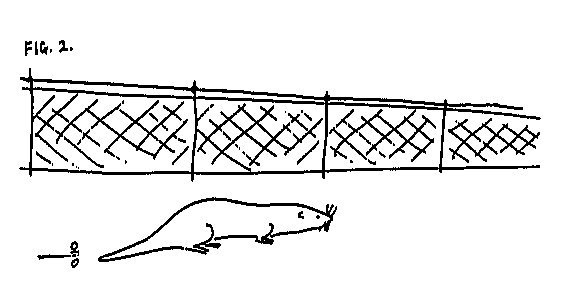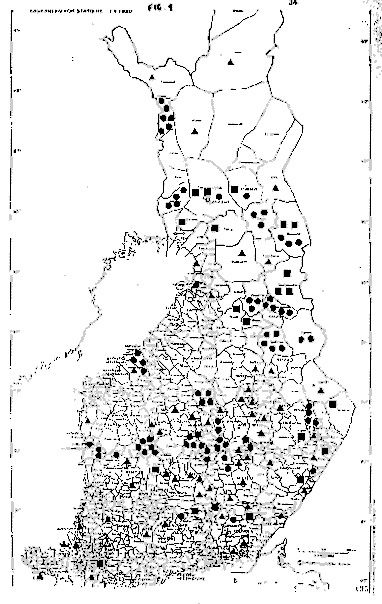|
Volume 5 Pages 1 -
83 (March 1990)
Citation:Skáren,U.
(1990) Fish farming and otters
in Finland. IUCN Otter Spec. Group Bull. 5: 28 - 34
Previous | Contents | Next
Fish farming and otters in Finland
Uolevi Skáren
Kp 2/82, 74300 Sonkajärvi, Finland
Abstract: The results of a questionnaire sent to
all fishfarmers in Finland are presented; 45% replied. There appear to be
good otter populations in Finland. Frequency and amount of damage to
stocks is discussed. An electric fence system that has been found useful
in excluding otters from fish farms is described. Only a few farmers
consider otters a grave pest. The major threat to otters in Finland seems
to be traffic accidents as car numbers increase. Further information is
needed to confirm the findings, and to ensure confusion with mink does not
occur. |
INTRODUCTION
Fish farming in Finland has very much increased in the 1980s. Rainbow trout (Salmo
gairdneri) is the main (99%) product with a record yield of 13,000 metric
tons in the year 1988. At the same time our natural catch of salmonids was much
lower (1.2 metric tons in 1986) (Anonymous. 1988; 1989).
Otters are not protected at fish farms and the Finnish state does not yet
compensate for losses. Therefore in early 1980 a questionnaire was sent by WWF
to all known fish farmers (n = 778) to determine how many otters have been
killed and how great have been the financial losses. Other questions were also
included. Some 45% of the farmers returned the form.
RESULTS
- Distribution of Otters in Finland
Because there are fish farms all over the country, the present data probably
describe the main distribution of otter populations in Finland. Otters
are rare or absent in the coastal regions (Figure 1)
while there are good populations in inland, central and eastern parts of the
country. Also populations in southern and western Lapland seem to be
viable, even though it is difficult to determine what constitutes a viable
population.
- Frequency of Visits
Most fishfarmers (69%) reported that otters visit in autumn and
winter. Mostly they stay for a couple of days twice a month.
However, sometimes otters lived on the farms almost continuously round the
whole year. But 61 persons wrote that otters never visited the farms
although they lived on the adjacent areas. There was no correlation with
e.g. the latitude and the frequency of visits.
- Numbers of otters killed on the fish farms.
Altogether at least 76 otters were killed In the 1980s (Figure
1). Most of them (at least 42%) were shot while only 16% were killed
with traps. The rest were caught e.g. in live-traps, drowned in fish traps
or killed by dogs. Only 23 otters were killed before the year 1980 in fish
farms. This may reflect both the increasing population of otters and the
growth of fish farming.
- Damage done by Otters in Fish Farms
The total yearly losses were about 75,000 US dollars. One third of
them was reported from the Oulu province (Figure 1)
but occasionally otters caught much fish elsewhere too. In an extreme case,
in the year 1988, two otters ate 4500-5000 trout of two years age . Their
value was estimated as 7500 US dollars.
Sometimes surplus killing was apparent. Once in late winter seven trout of
1kg were found in snow. Each of them had been bitten in the throat. There
were only otter tracks on the river bank. Likewise in autumn 1988 altogether
19 trout of 1.5kg were once found in western Lapland on a 200m length of
river bank. They had not been eaten, only bitten in the throat.
There was no snow at that time, thus the killer could have been a
mink. But up to five otters were seen together there.
- How to prevent the Damage
Several fish farmers have tested different fences to prevent otters coming
in. Possibly one of the best is a 50cm high, 20-50mm mesh metal fence made
of 1mm wire. Five cm above it is a low voltage electric wire normally used
to constrain cattle (Figure 2). After snow
storms, the snow along the fence was trampled under foot.
 |
| Figure 2: An electric
fence preventing otters intruding into fish farm |
In snowless areas, a I5 cm high fence suffices. This fence consists of
light glass fibre stakes and two electric cattle-wires 10 and 15cm from the
surface of the earth.
An old man was once looking out of the window when an otter came its usual
way into the fish farm without knowing that there was now a new, low
electric fence. It ran into the fence, jumped up and returned quickly. Later
the otter always went round the fence at a distance of 100m.
- Attitude to Otters
Over one hundred fish farmers said they would, in principle, give the
trapped otters to WWF in order to transport them to other areas. But
the problem remains to find a place remote enough from fish farms.
Some wrote that it is nice to see otters and the damage they do is not too
great. Only a few farmers consider otters as serious pests and curse
that it is very difficult to get rid of these intelligent animals.
Many farmers would give the carcasses of killed otters to zoologists if
collection was organized.
- Discussion
Certainly additional data are needed to clarify the distribution of otters
in Finland. According to the map of Vikberg et al (1989) otters should also be found in several places on the coastal area. In the
present material there are two reports even on the Åland Islands which are
otterless according to both Kaikusalo (1984a) and Vikberg
et al. (1989). It. is possible that there is some confusion with mink -
or otters are returning to the archipelago.
Many otters are probably killed each year in Finland. Certainly many cases
are not reported at all. At least 180 otters were brought to Finnish museums
in the 1980s (pers. comm.). A minimum of 256 otters were killed in Finland
during the last ten years.
Kaikusalo (1984b) estimated. based on questionnaires
that tens of otters die annually in Finland in fish traps and traffic
accidents. The last named are an increasing menace because the number
of cars grows rapidly. At the same time, hunters demand the restarting
of otter hunting.
In Sweden, otter populations seem to be low even in the best areas.
Dead otters are given to Naturhistoriska Rijksmuseet in Stockholm.
Between 1965-85 altogether 65 otters were received (Olssen
et al, 1985).
Vikberg et al (1989) suggested that the growing fish farming has been a benefit to otters because they now get plenty of food. However, otters are
also killed in fish farms. The increasing fish farming cannot be the
reason for increasing numbers of otters in the 1980s, because salmonids form
only a minor part of the food of otters thus far studied in Finalnd (Skarén,
unpublished data).
REFERENCES
Anonymous (1988). Kirjolohentuotanto 15 milj.kg
vuonna 1988. Suomen Kalastuslehti 95:362.
Anonymous (1989). Kalanviljely Suomessa vuonna
1987. Suomen Kalastuslehti 96:92-93.
Kaikusalo, A. (1984a). Kuinka saukolla sujuu? Eläinmaailma 6: 46-47.
Kaikusalo. A. (1984b). Saukot alamäessä. Nuorten
Luonto 41:8-9.
Koenig, W.D. (1988) On determination of viable
population size in birds und mammals. Wildl. Soc. Bull. 16:
230-234.
Olsson, M., Rosendal, E. & Sandegren. F. (1989).
Utterinventering i Ljusnans och Dalälvens avrinningsområden.Viltnytt 27:
51-56.
Vikberg. P., Mollanen. P. & Lehtinen. A. (1989).
Saukkomme Suomessa. Metsästäjä 38: 48-51.
Previous | Contents | Next
|


